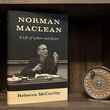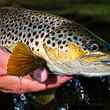We let our verdict on Scott’s new Centric slip by including it in the February 2021 installment of our regular “Gear We Love Right Now” feature, noting that the Centric had been a do-it-all performer since it showed up on our doorstep last fall. But there’s a lot more to ground to cover when it comes to Scott’s new flagship freshwater rod series, and that’s what we aim to do here.
As detailed in the aforementioned column, the Scott Centric “hit the market last year not as the little engine that could, but as the little engine that absolutely had to.” And that’s because, with the introduction of the Centric, Scott was replacing the enormously successful Scott Radian, one of the most heralded fly rods of all time—a rod that prompted trusted experts like Kirk Deeter to ask whether, in the Radian, Scott had created the greatest fly rod ever made. Remarkably versatile, dependable, and accurate performers, Radians were (and still are) coveted by most anglers.
Graduating from such a success story carries with it lofty expectations. Expectations not just for a rod to offer improvements over its predecessor, but not to screw up any of its virtues in the process. As we noted back in February, by our measure, with the new Centric, Scott has succeeded on all accounts.
What Works
Craftsmanship + Componentry
Every angler has their own opinion of what a fly rod is supposed to look like, what character the implement they chase fish with is supposed to take on. For some, there’s no higher form of art than the classic aesthetics of an heirloom bamboo or fiberglass rod. For others, a design that eschews traditional boundaries and pushes fly fishing into the 21st century is their go-to. Scott has always done a great job of pulling from both these sources for inspiration, producing rods that look both classic and classy, while at the same time looking like the modern technological marvels that they are.


The Scott Centric is no exception. Black and crimson red thread wraps bind universal snake brand and titanium stripping guides to a carbon-colored, unsanded blank (as is Scott’s hallmark). Like all of Scott’s rods, the Centric is handmade, one-by-one in Scott’s Montrose, CO facility. Componentry is first-rate, as one would expect, with zirconium-ringed titanium stripping guides, new low-glare snake guides for extra stealth, and gorgeous Flor-grade cork. And, if it’s possible to love a reel seat, then you’ll love the new, fully-machined reel seat Scott built for the Centric. I’ve fiddled with clumsy (and sometimes straight-up cheap) reel seats on more high-end fly rods than I can count. The reel seat on the Centric, on the other hand, is a thing of beauty that seems to work flawlessly every time.
Accuracy
Accuracy is one of those terms that gets thrown around a lot when talking about fly rods. And it’s one that, as we’ve suggested before, gets thrown around improperly. Fly rods can’t be accurate, only anglers can be. What most folks mean when they say that a fly rod is accurate, is that, when casting it, the rod travels in the direction you tell it to, with predictable, repeatable performance. That’s precision, not accuracy.
The reason that precision is important is because the less precise a rod is, the more the tracking of the rod (and thus the path of your fly line) will vary. Mostly, this comes down to torsional stability, horizontal wobble, tip-wobble, or whatever you want to call it: how well the rod’s path retains the plane of travel imparted by the angler’s casting stroke. A poor caster will induce considerably more horizontal wobble than a skilled caster, but all casters benefit from a rod that—by offering enhanced stability across multiple axes—resists torsion and wobble. Rods that resist wobble track far better—are more precise—than those that don’t.
The Radian excelled at resisting wobble thanks to Scott’s ARC (Advanced Reinforced Carbon 2) system, unidirectional carbon fiber reinforcements that provide directional stability. The new Centric features the new incarnation of ARC, cleverly dubbed ARC2, which Scott says offers even more torsional stability while adding 35% less weight.
The result is a rod that is so light it almost disappears in your hand and that tracks as dependably as any we’ve cast in memory. The Centric will put your fly precisely where you tell it to. Whether that’s where it should go is still up to you.
Responsiveness
The Radian’s defining characteristic was its “fast meets feel” action. Though certainly not the only, Scott was one of the first rod makers to offer a fast-action fly rod that recovered (returned to straight after being bent) quickly while actually allowing anglers to feel the rod load through the cast (in other words, it actually bent). Traditionally, fast simply meant stiff. But as materials and technology have improved, rod makers have been able to deliver sticks that both bend and recover quickly. Scott’s Radian excelled at this, perhaps more than any other rod on the market, a fact Scott was proud to highlight.
And it is responsiveness, more than any other quality, that most would agree Scott was obligated to, at the very least, preserve whenever the time came to graduate from the Radian. The good news is that the Centric does more than just carry along the responsiveness of the Radian, it improves upon it.

Cast the do-it-all 9 foot 5 weight Centric (which will feel like a 4 weight in your hand) and you’ll be surprised how deeply the rod loads into the blank, how quickly it recovers, and how effortlessly such a lightweight package generates line speed. There have been more days that I can count where I’ve remarked about how the Centric feels like one of my dry fly-specialist 4 weights in my hand, but allows me to generate line speed and carry line in ways I’d associate more with one of my 6 weight streamer rods. Perhaps more importantly, because the Centric bends deep into the bank, it allows me to push or back off the rod as much or as little as I need to (within reason).
Tippet Protection
If you’re not familiar with tippet protection, essentially all it refers to is how soft and/or sensitive a rod’s tip section is. When stiff tips require too much force to bend, they’ll significantly increase the likelihood of snapping light tippets (normally 6x or lighter, but sometimes 5x, too) when playing a fish.
Tippet protection seems like one of those things that’s not all that important, and for some anglers it’s not. But in my experience, good fish fighting skills are far more rare than good casting skills. For those that lack either the experience or that sixth sense, if you will, that tells you when to put pressure on a fish and when to ease off, that lets you “feel” when a fish is about to take another run when most anglers might think the fish was ready for the net, that intuitively directs your rod angle throughout the fight, and so on, tippet protection really matters.
If there was one area where Scott had room to improve upon the Radian, tippet protection was it. Unlike its predecessor, which was relatively average at protecting light tippets, the Centric excels at it. Despite its quick recovery, the Centric’s tip is surprisingly supple and plays light tippets with care. If you’re not completely ham-handed when fighting fish, the Centric—despite its fast, responsive action—won’t present any liabilities when it comes to fishing to larger fish on light tippets.
Versatility
The bits and pieces we’ve discussed thus far—the Centric’s precision, responsiveness, and excellent tippet protection—translate into a great deal of versatility.
The Centric has been a workhorse rod for us these past few months, handling wildly varying conditions with elegance and grit—whether dredging heavy nymph rigs down deep to lethargic, lazy trout; slinging streamers for big winter browns; or casting tiny midges on delicate tippet during impromptu hatches. Line control is excellent, making both on-the-water and aerial mends surprisingly effortless.
It’s well known that 9 foot 5 weight fly rods are ubiquitous, thanks to being endlessly put forth as the “do-it-all” size for trout anglers. Over the years, I’ve never really found that to be the case. As a result, I’ve gravitated away from 5 weight rods and to more task-specific weights. If I want a rod mainly for delivering delicate presentations to wary trout, I’ll most often go with a 4 weight or lighter. Fishing streamers? I’ll reach for a 6 or 7 (or even an 8). Flipping big nymph rigs? Give me a 3 or 4 weight that’s 10 feet or longer. Certainly, 9 foot 5 weight fly rods have long represented the middle ground when it comes to trout rods, but that’s distinctly different from being a do-it-all tool. Only a few select 9 foot 5 weights really do it all—everything from fishing delicate dries on light tippets to wary trout to hucking large streamers on polyleaders—while doing it well. The Centric is one of them. In fact, the Centric may be the truest "do-it-all" trout rod on the market right now.
What Doesn’t
Creek Duty
It should likely go without saying that the Centric isn’t a tiny creek rod. But, being that there are trout in tiny creeks, inevitably an angler will bemoan the fact that the Centric isn’t performing well for him or her on those waters. As good as the Centric is, even up close, for the really short stuff like you’ll commonly be tasked with on small mountain creeks (think 15-20 feet or shorter), the Centric isn’t your tool of choice. And that’s not surprising, given it’s not made for those sorts of fisheries. If most of your time is spent casting short lines to small trout, look elsewhere. If Scott is your target of choice, consider their fiberglass F series, which is an endless joy, or their medium-action G series.
Final Word
In a market where fly rods seem to blink in and out of existence on ever-shorter timeframes as part of a race to capture eyes and ears with the latest and greatest, the Radian sat atop Scott’s lineup as its flagship freshwater rod for 8 long years. If you spend time talking with Scott Fly Rods president and rod designer Jim Bartschi, you’ll understand why, as you’ll learn about Scott’s philosophy of only making a new fly rod when they’re able to offer anglers significant improvements over the rods currently in the Scott lineup. “We’re always trying,” Bartschi said to me while chatting about Scott’s saltwater Sector a few years back. “But until we actually can, we don’t.”
And so by virtue of this philosophy, Scott set the expectation that whatever replaced the Radian would, in fact, offer tangible advantages to anglers. And the Centric does just that, while staying true to its fast-meets-feel roots. The Scott Centric is in every way a worthy heir to the Radian's throne, one that feels like a true evolution of technology and design rather than a variant or replacement.
If you haven't already taken notice of the Scott Centric, be sure to add it to your "must cast" list as you awake from your fly fishing slumber this spring.





























Comments